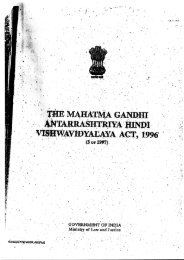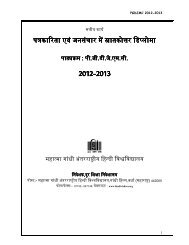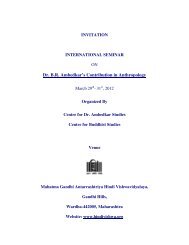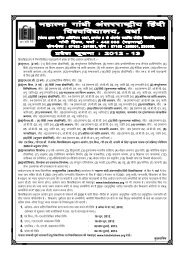Mamta Kalia
Mamta Kalia
Mamta Kalia
Create successful ePaper yourself
Turn your PDF publications into a flip-book with our unique Google optimized e-Paper software.
separations between high culture and<br />
mass or popular culture have disappeared<br />
in present age. Like Baudrillard, he also<br />
finds a causal relationship between new<br />
developments in western capitalism and<br />
the rise of the post-modern- ‘a new society<br />
of the media or the spectacle or<br />
multinational capitalism’, characterised<br />
by new consumption patterns, fast<br />
changing fashion and style, planned<br />
obsolescence, ubiquitous presence of<br />
advertising and the media (especially<br />
TV), explosion of suburbia (at the expense<br />
of city and rural areas) and automobile<br />
culture. In this list, one may add internet,<br />
mobile phone and fast food culture. The<br />
deeper logic of new social system has<br />
led to ‘the disappearance of a sense of<br />
history’ in the culture, to a persuasive<br />
depthlessness and to a ‘perpetual present’<br />
from which the memory of tradition has<br />
disappeared. In post –modern art, he<br />
observes, the deeper logic of new social<br />
system brings two features: (a) ‘pastiche’<br />
and (b) ‘schizophrenic discontinuity’.<br />
Pastiche is a ‘blank parody’- without<br />
parody’s ‘ulterior motive, without<br />
satirical impulse, without laughter,<br />
without that still latent feeling that there<br />
exists something normal compared to<br />
which what is being imitated is rather<br />
comic. In this context we may cite the<br />
various laughter programmes on Hindi<br />
channels in India or even such<br />
programmes like ‘America’s Funniest<br />
Videos’ on foreign English channels which<br />
are more imitative, artificially comic,<br />
unrealistic and remote from normality.<br />
78 :: April-June 2010<br />
Further these programmes make the<br />
audience insensitive to the victims of<br />
accidents and even tragedies – laughing<br />
when one falls! On the other hand, his<br />
concept of ‘schizophrenic discontinuity’<br />
is a language disorder resulting from<br />
the subjet’s failure ‘ to accede fully into<br />
the realm of speech and language’. He<br />
elaborates that since language gives us<br />
our experience of temporality, human<br />
time, past, present, memory, the<br />
persistence of personal identity’, such<br />
a failure leads to an absence of the<br />
experience of temporal continuity in the<br />
patient who is condemned to live in<br />
a perpetual, always discontinuous,<br />
present: ‘schizophrenic experience is an<br />
experience of isolated, disconnected,<br />
discontinuous material signifiers which<br />
fail to link up into a coherent sequence.<br />
Thus it transpires that Jameson’s postmodernism<br />
is ‘ the transformation of<br />
reality into images, the fragmentation<br />
of time into a series of perpetual presentshistory<br />
has disappeared and the present<br />
is dissolved in images. In his view, the<br />
pastiche and radical discontinuity had<br />
only a marginal place in the ‘modernism<br />
proper’ but now they have a central<br />
place in the contemporary cultural<br />
production. Unlike Lyotard, who<br />
perceived anti-representationism as a<br />
necessary defensive maneuvre against<br />
the terror of representational consensus,<br />
Jameson argues about the impossibility<br />
of representation as the end of an<br />
emancipatory politics. He saw later<br />
(1984) post-modernism ‘dialectically as

















